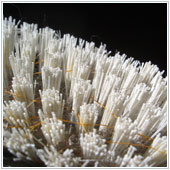Most computer users, that is to say nearly everyone, take steps to protect the data and information within their computer, diligently employing and running anti-virus scanners and generally focusing on keeping their computer safe. This form of digital preventative maintenance is important, but it’s also equally important to do some preventative maintenance to the physical machine itself.
Here’s the main external parts of your computer you should clean on a regular basis and how to go about doing so. We recommend that you exercise caution when opening the case to your computer and not to just go in and clean willy-nilly. Some internal components are incredibly fragile and you could render your computer useless.
Keyboard
Most people naturally rest one hand on the keyboard, this near constant contact means oil and dirt from your fingers will be transferred to the keys, causing a buildup of grime overtime. You may also find other nasties like crumbs get under the keys and can potentially hinder the operation of the keys.
The best way to clean a keyboard is by using compressed air, which can be found at any store that sells computers or computer parts. When cleaning, hold your keyboard upside down and blow the air into the spaces inbetween the keys. Sir Isaac Newton’s good friend gravity will take care of the rest.
If you have grime on the keys, you can use a number of methods to remove it. The most popular is to use distilled, denatured isopropyl alcohol – commonly called electronics cleaner – and a lint-free cloth. Dip the cloth in the alcohol and gently rub it over the keys, you’ll be amazed at how much gunk will come off. For spaces in between the keys, use a cotton swab/Q-tip.
Before you attempt to clean the keyboard, be sure to unplug it from your computer. If you use a laptop, turn it off and disconnect the power cord. Whatever you do, don’t spray or splash liquid on the keyboard this will likely cause it to stop working. You should take care not to use bleach, acetone, ethyl alcohol, acid or pure water. While these liquids will clean the keyboard, some tend to eat through plastic, or just straight up ruin anything electrical; best to avoid them.
Mouse
Once your keyboard is spic-and-span, it’s time to look at your mouse. As with the keyboard, unplug it before you clean it. For mice with trackballs, flip them over and undo the cover that keeps the ball in place – usually achieved by turning the cover clockwise – take the ball out and gently scrape any lint or gunk off the rollers on the side of the area where the ball is housed.
For optical mice, using a Q-tip/cotton swab dipped in isopropyl alcohol to gently wipe down the mouse will work wonders.
Monitor
Monitors, regardless of style, are dust and fingerprint magnets. To clean your monitor: turn it off unplug it, and run a lint-free cloth over the glass in a circular motion. If it’s really dirty, glass cleaner can be used. However, be warned that industrial glass cleaner will remove the anti-glare coating on the monitor, so look for a glass cleaner that’s safe to use on monitors instead – it should say so on the bottle.
Connector cables
Cables are often the most neglected part of a computer, normally because they are black and it’s near impossible to see the dirt. Any Mac user who has had a laptop for a number of years can attest that the once white charging cord isn’t as white as it was when brand new. To clean any cable, first disconnect it from the power source. Use a cloth or Q-tip/cotton swab dampened in your, by now, good cleaning friend, denatured isopropyl alcohol, to clean the cable.
If the connector ports of the cable are dirty, don’t go dipping them in any liquid, this will likely ruin them. Instead, look for isopropyl rubbing pads, which have been dipped in a 99% isopropyl alcohol solution. If the isopropyl alcohol you have used for cleaning the other components is 99%, you can also use a cotton swab dipped in this solution. Just be careful not to apply any force and ensure the connector dries quickly.
Inside the case
If you have a desktop, with a tower, chances are there’s a fair amount of dust inside the computer. This dust can slow components down, decrease the computers cooling ability and has, if left unabated, been known to be the cause of electrical fires.
Companies that have rented their computers from a vendor, or have machines still on warranty should not open the case, as they will void the warranty. If you feel the internal components need to be cleaned, contact your vendor and ask if they can come and clean your systems.
If you’re more of a do-it-yourself person, you can open the case to clean inside. Be sure to unplug ALL cords and when you lift the case off keep your hand on the metal frame. Be careful to touch NO COMPONENTS as a static shock could ruin them. Touching the metal part of the case should ground you. After that, you can use compressed air to blow the dust out of the case. You may want to do this away from the area where your computer is, as there can be a lot of dust.
After you have your computer case back on, plug in everything and start your showroom clean computer up. You may even notice it runs faster, or at the very least looks good. If you feel it’s time for a computer clean-up and have any questions then please contact us.
Published on 27th September 2012 by Jeanne DeWitt.


